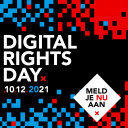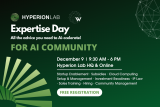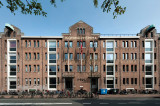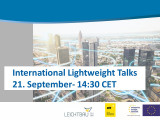Stay in the know on all smart updates of your favorite topics.
Sensemakers Latest on VR/AR/MR

Sensemakers can finally meet offline, this evening we'll meet at NewBase on the Marineterrein, as to learn about the latest in VR, AR and MR, and depending on the amount of people some will also have the opportunity to try it out!
Looking forward to talk to you all again!!
Open Call for city governments and experts to pilot city-wide implementations of digital rights

The Cities Coalition for Digital Rights, UN-Habitat, UCLG and Eurocities, in partnership with Open Society Foundation, are launching an open call to find experts and city governments in Europe to pilot the Digital Rights Governance Framework.
Selected cities will receive support to design and implement the Digital Rights Governance Framework at the local level, and will be provided with technical advice, ad hoc support and advisory input.
The goal of the project is to tackle local digital-rights challenges around digital rights thematic areas such as digital inclusion, individual’s control and autonomy of data, transparency and accountability, public participation and community engagement, privacy, digital public goods and open digital infrastructures, procurement by developing a Digital Rights Governance Framework and a capacity-building programme in these topics.
Using challenge-driven innovation, the pilot process will include assessments, workshops and a capacity-building approach that will be carried out in collaboration with the city’s local staff.
The call is open to:
- “CITIES”, where city governments in Europe are welcome to apply by sharing local challenges in the different digital rights areas
- “EXPERTS”, for professionals with background in the thematic areas related to digital rights
Find out more and submit your application via: https://citiesfordigitalrights.org/opencall
Deadline: Sunday, 27 February 2022
AIMD ontvangt ruim 2 miljoen euro voor mensgericht AI-onderzoek

Het AI, Media & Democracy Lab, een samenwerking van UvA, HvA en CWI, krijgt een subsidie van 2.1 miljoen euro toegekend binnen de NWO-call ‘Mensgerichte AI voor een inclusieve samenleving – naar een ecosysteem van vertrouwen’. Hiermee gaan onderzoekers in de zogenoemde ELSA Labs zich samen met mediabedrijven en culturele instellingen inzetten om de kennis over de ontwikkeling en de toepassing van betrouwbare, mensgerichte AI te vergroten.
In totaal honoreert NWO in deze call vijf aanvragen; bij elkaar gaat het om meer dan 10 miljoen. HvA-lectoren Nanda Piersma en Tamara Witschge en Hoofddocent Responsible AI Pascal Wiggers hebben zich hier - samen met vele anderen - tot het uiterste voor ingespannen.
Het AI, Media & Democracy ELSA Lab is een van de gehonoreerde projecten binnen de categorie Economie, Binnenlands bestuur en Cultuur & Media, en onderzoekt de impact van AI op de democratische functie van media. Samen met journalisten, mediaprofessionals, designers, burgers, collega-onderzoekers en publieke en maatschappelijke partners, ontwikkelt en test het lab waarde-gedreven, mensgerichte AI-toepassingen en ethische en juridische kaders voor verantwoord gebruik van AI.
Doel van het Lab is het stimuleren van innovatieve AI-toepassingen die de democratische functie van media versterken. Er wordt samengewerkt met partners als RTL, DPG Media, NPO, Beeld en Geluid, Media Perspectives, NEMO Kennislink, Waag Society, Gemeente Amsterdam, Ministerie van Binnenlandse Zaken en Koninkrijksrelaties, Ministerie van Onderwijs, Cultuur en Wetenschap, Commissariaat van de Media, Hogeschool Utrecht, Universiteit Utrecht, Cultural AI Lab, Koninklijke Bibliotheek, BBC en het Bayrischer Rundfunk AI Lab.
ENORME IMPULS
Prof. dr. Natali Helberger , universiteitshoogleraar Law and Digital Technology aan de UvA en medeoprichter van het AI, Media & Democracy Lab: "Deze subsidie stelt ons in staat om samen met onze partners te onderzoeken hoe AI een rol kan spelen in de democratische en onafhankelijke rol van de media, de publieke sfeer en burgers die zich willen informeren. Met het AI, Media & Democracy Lab kunnen we onze bijdrage leveren aan onafhankelijke innovatie, maar ook aan het vormen van een visie op de toekomst van de media in onze digitale maatschappij."
Dr. Nanda Piersma , wetenschappelijk directeur van het Centre of Expertise Applied AI, HvA-lector Responsible IT en onderzoeker bij CWI: "We willen een verschil maken in het huidige medialandschap door samen met de mediapartners en de publieke partners AI op een verantwoorde manier in de praktijk te brengen. Deze subsidie stelt ons in staat om een experimentele ruimte te creëren waar we AI kunnen uitproberen, en bij goed resultaat ook met de partners in de praktijk te implementeren. Daarmee krijgt het Nederlandse medialandschap een enorme impuls.”
Dr. Tamara Witschge, HvA-lector Creative Media for Social Change: “Met dit consortium van kennisinstellingen kan de HvA echt een belangrijke bijdrage leveren, omdat het gaat over het ontwikkelingen van technologische innovaties die publieke waarden en grondrechten borgen en mensenrechten respecteren, en deze in de journalistieke praktijk te testen. In het project komen de verschillende expertisegebieden van de faculteit Digitale Media en Creatieve Industrie samen: van AI tot media en design.”
GRONDRECHTEN, MENSENRECHTEN EN DRAAGVLAK
De ELSA Labs (ELSA: ‘Ethical, Legal and Societal Aspects’) zijn co-creatieve omgevingen waar interdisciplinair en met elkaar samenhangend onderzoek wordt gedaan naar verschillende technologische en economische uitdagingen waar we als samenleving voor gesteld worden. Het met de NWO-subsidie gefinancierde onderzoek moet niet alleen bijdragen aan technologische innovaties die publieke waarden en grondrechten borgen en mensenrechten respecteren (en waar mogelijk versterken), maar ook op maatschappelijk draagvlak kunnen rekenen. Nanda Piersma: ”We zijn trots dat het AI Media and Democracy Lab eerst het NLAIC ELSA label heeft gekregen en nu ook deze subsidie van NWO. Het voelt dat we het vertrouwen hebben gekregen en we willen dit maximaal waarmaken in de komende jaren.”
OVER MENSGERICHTE AI
NWO en de Nederlandse AI Coalitie hebben, als onderdeel van de Nationale Wetenschapsagenda (NWA), het programma ‘Artificiële Intelligentie: Mensgerichte Artificiële Intelligentie (AI) voor een inclusieve samenleving – naar een ecosysteem van vertrouwen’ gelanceerd. Het programma bevordert de ontwikkeling en toepassing van betrouwbare, mensgerichte AI.
In dit publiek-private samenwerkingsverband werken overheid, bedrijfsleven, onderwijs- en onderzoeksinstellingen en maatschappelijke organisaties samen om de nationale AI-ontwikkelingen te versnellen en bestaande initiatieven met elkaar te verbinden. Dit NWA-onderzoeksprogramma verbindt AI als sleuteltechnologie met AI-onderzoek voor een inclusieve samenleving. Daarbij spelen de nationale onderzoeksagenda AIREA-NL en maatschappelijke en beleidsvraagstukken een belangrijke rol.
Ethical principles and artificial intelligence

In the 11th episode of the series Better cities: The contribution of digital technology, I will apply the ethical principles from episode 9 to the design and use of artificial intelligence.
Before, I will briefly summarize the main features of artificial intelligence, such as big data, algorithms, deep-learning, and machine learning. For those who want to know more: Radical technologies by Adam Greenfield (2017) is a very readable introduction, also regarding technologies such as blockchain, augmented and virtual reality, Internet of Things, and robotics, which will be discussed in next episodes.
Artificial intelligence
Artificial intelligence has valuable applications but also gross forms of abuse. Valuable, for example, is the use of artificial intelligence in the layout of houses and neighborhoods, taking into account ease of use, views and sunlight with AI technology from Spacemaker or measuring the noise in the center of Genk using Nokia's Scene Analytics technology. It is reprehensible how the police in the US discriminate against population groups with programs such as PredPol and how the Dutch government has dealt in the so called ‘toelagenaffaire’.
Algorithms
Thanks to artificial intelligence, a computer can independently recognize patterns. Recognizing patterns as such is nothing new. This has long been possible with computer programs written for that purpose. For example, to distinguish images of dogs and cats, a programmer created an "if....then" description of all relevant characteristics of dogs and cats that enabled a computer to distinguish between pictures of the two animal species. The number of errors depended on the level of detail of the program. When it comes to more types of animals and animals that have been photographed from different angles, making such a program is very complicated. In that case, a computer can be trained to distinguish relevant patterns itself. In this case we speak of artificial intelligence. People still play an important role in this. This role consists in the first place in writing an instruction - an algorithm - and then in the composition of a training set, a selection of a large number of examples, for example of animals that are labeled as dog or cat and if necessary lion tiger and more . The computer then searches 'itself' for associated characteristics. If there are still too many errors, new images will be added.
Deep learning
The way in which the animals are depicted can vary endlessly, whereby it is no longer about their characteristics, but about shadow effect, movement, position of the camera or the nature of the movement, in the case of moving images. The biggest challenge is to teach the computer to take these contextual characteristics into account as well. This is done through the imitation of the neural networks. Image recognition takes place just like in our brains thanks to distinguishing layers, varying from distinguishing simple lines, patterns, and colors to differences in sharpness. Because of this layering, we speak of 'deep learning'. This obviously involves large data sets and a lot of computing power, but it is also a labor-intensive process.
Unsupervised learning
Learning how to apply algorithms under supervision produces reliable results and the instructor can still explain the result after many iterations. As the situation becomes more complicated and different processes are proceeding at the same time, guided instruction is not feasible any longer. For example, if animals attack each other, surviving or not, and the computer must predict which kind of animals have the best chance of survival under which conditions. Also think of the patterns that the computer of a car must be able to distinguish to be able to drive safely on of the almost unlimited variation, supervised learning no longer works.
In the case of unsupervised learning, the computer is fed with data from many millions of realistic situations, in the case of cars recordings of traffic situations and the way the drivers reacted to them. Here we can rightly speak of 'big data' and 'machine learning', although these terms are often used more broadly. For example, the car's computer 'learns' how and when it must stay within the lanes, can pass, how pedestrians, bicycles or other 'objects' can be avoided, what traffic signs mean and what the corresponding action is. Tesla’s still pass all this data on to a data center, which distills patterns from it that regularly update the 'autopilots' of the whole fleet. In the long run, every Tesla, anywhere in the world, should recognize every imaginable pattern, respond correctly and thus guarantee the highest possible level of safety. This is apparently not the case yet and Tesla's 'autopilot' may therefore not be used without the presence of a driver 'in control'. Nobody knows by what criteria a Tesla's algorithms work.
Unsupervised learning is also applied when it comes to the prediction of (tax) fraud, the chance that certain people will 'make a mistake' or in which places the risk of a crime is greatest at a certain moment. But also, in the assessment of applicants and the allocation of housing. For all these purposes, the value of artificial intelligence is overestimated. Here too, the 'decisions' that a computer make are a 'black box'. Partly for this reason, it is difficult, if not impossible, to trace and correct any errors afterwards. This is one of the problems with the infamous ‘toelagenaffaire’.
The cybernetic loop
Algorithmic decision-making is part of a new digital wave, characterized by a 'cybernetic loop' of measuring (collecting data), profiling (analyzing data) and intervening (applying data). These aspects are also reflected in every decision-making process, but the parties involved, politicians and representatives of the people make conscious choices step by step, while the entire process is now partly a black box.
The role of ethical principles
Meanwhile, concerns are growing about ignoring ethical principles using artificial intelligence. This applies to near all principles that are discussed in the 9th episode: violation of privacy, discrimination, lack of transparency and abuse of power resulting in great (partly unintentional) suffering, risks to the security of critical infrastructure, the erosion of human intelligence and undermining of trust in society. It is therefore necessary to formulate guidelines that align the application of artificial intelligence again with these ethical principles.
An interesting impetus to this end is given in the publication of the Institute of Electric and Electronic Engineers: Ethically Aligned Design: A Vision for Prioritizing Human Well-being with Autonomous and Intelligent Systems. The Rathenau Institute has also published several guidelines in various publications.
The main guidelines that can be distilled from these and other publications are:
1. Placing responsibility for the impact of the use of artificial intelligence on both those who make decisions about its application (political, organizational, or corporate leadership) and the developers. This responsibility concerns the systems used as well as the quality, accuracy, completeness, and representativeness of the data.
2. Prevent designers from (unknowingly) using their own standards when instructing learning processes. Teams with a diversity of backgrounds are a good way to prevent this.
3. To be able to trace back 'decisions' by computer systems to the algorithms used, to understand their operation and to be able to explain them.
4. To be able to scientifically substantiate the model that underlies the algorithm and the choice of data.
5. Manually verifying 'decisions' that have a negative impact on the data subject.
6. Excluding all forms of bias in the content of datasets, the application of algorithms and the handling of outcomes.
7. Accountability for the legal basis of the combination of datasets.
8. Determine whether the calculation aims to minimize false positives or false negatives.
9. Personal feedback to clients in case of lack of clarity in computerized ‘decisions’.
10. Applying the principles of proportionality and subsidiarity, which means determining on a case-by-case basis whether the benefits of using artificial intelligence outweigh the risks.
11. Prohibiting applications of artificial intelligence that pose a high risk of violating ethical principles, such as facial recognition, persuasive techniques and deep-fake techniques.
12. Revocation of legal provisions if it appears that they cannot be enforced in a transparent manner due to their complexity or vagueness.
The third, fourth and fifth directives must be seen in conjunction. I explain why below.
The scientific by-pass of algorithmic decision making
When using machine learning, computers themselves adapt and extend the algorithms and combine data from different data sets. As a result, the final ‘decisions’ made by the computer cannot be explained. This is only acceptable after it has been proven that these decisions are 'flawless', for example because, in the case of 'self-driving' cars, if they turn out to be many times safer than ordinary cars, which - by the way - is not the case yet.
Unfortunately, this was not the case too in the ‘toelagenaffaire’. The fourth guideline could have provided a solution. Scientific design-oriented research can be used to reconstruct the steps of a decision-making process to determine who is entitled to receive an allowance. By applying this decision tree to a sufficiently large sample of cases, the (degree of) correctness of the computer's 'decisions' can be verified. If this is indeed the case, then the criteria used in the manual calculation may be used to explain the processes in the computer's 'black box'. If there are too many deviations, then the computer calculation must be rejected at all.
Governance
In the US, the use of algorithms in the public sector has come in a bad light, especially because of the facial recognition practices that will be discussed in the next episode. The city of New York has therefore appointed an algorithm manager, who investigates whether the algorithms used comply with ethical and legal rules. KPMG has a supervisory role in Amsterdam. In other municipalities, we see that role more and more often fulfilled by an ethics committee.
In the European public domain, steps have already been taken to combat excesses of algorithmic decision-making. The General Data Protection Regulation (GDPR), which came into effect in 2018, has significantly improved privacy protection. In April 2019, the European High Level Expert Group on AI published ethical guidelines for the application of artificial intelligence. In February 2020, the European Commission also established such guidelines, including in the White Paper on Artificial Intelligence and an AI regulation. The government also adopted the national digitization strategy, the Strategic Action Plan for AI and the policy letter on AI, human rights, and public values.
I realize that binding governments and their executive bodies to ethical principles is grist to the mill for those who flout those principles. Therefore, the search for the legitimate use of artificial intelligence to detect crime, violations or abuse of subsidies and many other applications continues to deserve broad support.
Follow the link below to find one of the previous episodes or see which episodes are next, and this one for the Dutch version.
De komst van Artificial Intelligence, wat nu?

Het afgelopen jaar verschenen er tal van rapporten over digitalisering en technologisering. Maar wat kunnen we daarmee in 2022? Welke lessen kunnen we trekken voor de slimme stad? Welke ideeën kunnen ons gaan inspireren in dit nieuwe smartcityjaar?
Dit soort gesprekken voer je normaal gesproken als je elkaar tegenkomt tijdens een nieuwjaarsborrel, een congres of een andere netwerkbijeenkomst. Helaas kan dit nu even niet fysiek, maar gelukkig laat het digitale ons niet in de steek. Zo kunnen we toch met elkaar nieuwe kennis delen en verspreiden.
Daarom is de Future City Foundation op zoek gegaan naar de makers en bedenkers achter de rapporten. We gaan daarom in gesprek met columnist en hoogleraar Haroon Sheikh over wat we moeten doen kunstmatige intelligentie.
Wanneer? 9 februari van 9.00 – 10.00 uur
Kosten: Gratis
Artificial intelligence wordt in steeds meer sectoren gebruikt, maar wat moeten we ermee? Hoe kunnen we gebruik maken van deze nieuwe technologie en tegelijkertijd de risico’s ervan beperken? Welke kansen zijn er voor gemeentes?
Dat vragen we aan Haroon Sheikh, filosoof, bijzonder hoogleraar én projectcoördinator van het rapport over AI van de Wetenschappelijke Raad voor Regeringsbeleid. Wilt u weten hoe je AI zo inzet dat het een positieve bijdrage levert aan onze samenleving en hoe je misbruik door grote bedrijven voorkomt?
Heeft u een vraag aan Haroon Sheikh? Dan kunt u deze invullen in het aanmeldformulier. (We nemen dit mee in de voorbespreking en kunnen niet garanderen dat uw vraag wordt behandeld).
Meer weten?
Wilt u zich alvast inlezen? Sheikh’s columns zijn regelmatig te lezen in NRC Handelsblad, zoals in dit opiniestuk met Corien Prins (voorzitter van de WRR) over kunstmatige intelligentie. Lees een van zijn columns <b>hier</b>.
Of lees alvast het rapport van de Wetenschappelijke Raad voor Regeringsbeleid <b>hier</b> over de opgaves rondom AI waarin de Raad stelt dat Nederland niet goed is voorbereid op de ontwikkelingen van AI, waardoor kansen worden gemist én risico’s niet goed worden gezien.
The Creative Industry Program's

The Creative Industry Program's main objective is to enhance creative skills in all segments of the industry, stimulating the emergence of new business opportunities, in addition to offering business representation, professional education and technology for various creative sectors.
The Program works in the development of industries through forums, and through the articulation of a network that includes universities, development agencies, government and private initiative, and creative networks. Internationally, the Creative Industry Program is a reference for countries and international organizations.
Based on the needs and opportunities identified in the economic context, the Program works to develop innovative skills, in order to create a favorable environment for business.
The Creative Industry Program seeks to develop the potential of creative entrepreneurship networks, in addition to promoting distribution through communication channels.
to know more
Send us an email to motivaco@gmail.com
Leer meer over digitale rechten tijdens Digital Rights Day

Kom naar het 'Digital Rights Day' weekend op 10-12 december! Een weekend met talks, exposities en film screenings over het thema digitale rechten.
Meld je nu aan voor onderstaande gratis (online) activiteiten:
➡️ Digital Rights Talk – 10 december (online streaming van Pakhuis de Zwijger)
➡️ Online vertoning You Are Your Profile II – 11 december (online streaming)
➡️ Tentoonstelling NEMO Studio- Bits of You + Zintuigen van Amsterdam – 11 december
Voor meer activiteiten van Digital Rights Day en om je aan te melden, ga naar https://www.amsterdam.nl/innovatie/digital-rights-day/
Fellowship responsible IT for artistic researcher or artist
The Responsible IT research group at the Amsterdam University of Applied Sciences is offering a fellowship to an artistic researcher or an artist, aiming to create fresh future-oriented perspectives on digitization and public values.
For your call for proposal see the following link.
Making sense of the web3.0 creator economy, Metaverse & NFT's

This evening we invited Zoe Scaman & Rutger van Zuidam to share their insights!
Zoe Scaman is founder @ Bodacious, a strategy studio + building fandoms, creators, brands, blockchain + entertainment: https://zoescaman.substack.com/
Rutger van Zuidam, who's building @OdysseyMomentum, an open Source Web3 Metaverse Stack for Collaboration.
Imagine wordpress for web3.0 where everyone can create & own their own space! https://momentum.odyssey.org/
Expertise Day- All the advice you need to Ai-ccelerate!

Expertise Day: All the advice you need to AI-ccelerate. For startups, entrepreneurs, aspiring founders. For the AI community!
🗓 On December 9, Hyperion Lab and Women in AI Netherlands bring you all the experts you need to build and accelerate your AI, #HPC, or deeplearning startup for one whole day!
📝 Subsidies, cloud computing, sales, investment readiness, startup enablement, IP law, hiring, community building, you name it!
🧑🏾💻 👩🏻💻Learn from experts such as Sanin Saracevic from Maestral Solutions, Inc., Maarten Robbers from Ugoo B.V., David Power from EscherCloud, Maurice Beckand Verwee from Curiosity, Kyra Dresen from Volta Ventures, Margriet Larmit from ROM InWest, Holger Seitz from EP&C, Michael Koenka from Koenka & Partners, Oliviana Bailey from Women in AI Netherlands & EscherCloud.
Register your online or offline attendance for any of the sessions.
AMdEX Meetup over delen van sensor data op Marineterrein

Vanwege de nieuwe corona-regelgeving houden we op 2 december een online bijeenkomst via Zoom vanaf 16.30 uur. We geven je in korte tijd zoveel mogelijk informatie over hoe het gaat met AMdEX (Amsterdam Data Exchange) en de samenwerking met het Marineterrein. Zij willen de data, afkomstig uit de sensoren op het terrein, delen met geïnteresseerden. Natuurlijk moet dat wel op een manier die veilig en vertrouwd is.
Programma
- Welkom en introductie AMdEX – Willem Koeman (Amsterdam Economic Board)
- AMdEX, een vertrouwd grid voor het delen van data – Hayo Schreijer (deXes)
- Marineterrein Sensor Data: AMdEX en het Marineterrein werken samen aan het delen van sensordata – Tom van Arman (Tapp)
- AMdEX beleid – hoe dwing je regels digitaal af rondom het gebruik van (gevoelige) data af? – Thomas van Binsbergen (UvA)
- Q&A
Neem deel aan dit event via Zoom. Je bent welkom op 2 december om 16:30 uur.
Achtergrondinformatie
AMdEX (Amsterdam Data Exchange) is een open coalitie van bedrijven en onderzoeksinstellingen die samen een open en vertrouwde infrastructuur voor het delen van gegevens ontwerpen en ontwikkelen. De coalitie wil de overgang naar een eerlijke en vertrouwde digitale economie versnellen waarin individuen en organisaties de volledige controle hebben over hun gegevens.
Data: een belofte voor het leven in de stad. Data stellen ons in staat om de grote uitdagingen van moderne steden aan te pakken en ze schoner, veiliger en gezonder te maken. Helaas is toegang tot deze gegevens niet zo eenvoudig als het lijkt. Wie wil bedrijfsgevoelige data delen met een concurrent? Of privacygevoelige data? Door onzekerheid over veiligheid, privacy en data-eigendom wordt minder dan 1% van alle data daadwerkelijk gebruikt, gedeeld en geanalyseerd.
Join finale Amsterdam Science & Innovation Award online

The 9th of November, the Amsterdam Science & Innovation Award finale of 2021 will take place. Join us online and be a witness to exciting new ideas that will create a positive impact on society! Nine finalists will pitch their ideas and compete for three Innovation Awards in the categories Environment & Climate, Health and Society and € 10.000 to bring their idea a step closer to application. Also, three researchers will be honored with an Impact Award for their significant impact on society: Halleh Ghorashi (VU Amsterdam), Hergen Spits (Amsterdam UMC) and Jeroen Kluck Amsterdam University of Applied Sciences (HvA).
When: Tuesday 9 November 2021
Time: 15:00 - 17:00
HvA, HR and HU building the centre for Responsible Applied AI

The Amsterdam, Rotterdam and Utrecht Universities of Applied Sciences have received a SPRONG grant from Regieorgaan-SIA, with which they - together with 24 partners from the field - can build an infrastructure for a powerful research group. A group that is regionally and nationally recognised as the centre for practice-based research in the field of Responsible Applied AI.
Artificial Intelligence (AI) is developing rapidly with far-reaching consequences for the whole of society (all sectors, professions and citizens). Although AI offers new opportunities for institutions and (SME) companies, there are also many questions.
For example, there is a demand for research methods to meaningfully implement AI technology in a specific context (e.g. retail and care), taking into account the user and other stakeholders. There are also questions about the design process of AI solutions: how can you take ethical and social issues into account?
METHODOLOGY FOR RESPONSIBLE APPLIED AI
Current AI research is mostly fundamental and focused on technology. As such, it hardly provides answers to the questions mentioned above. The three universities of applied sciences in the SPRONG group conduct practice-oriented research into responsible AI solutions for companies and institutions. With these research experiences and results, the SPRONG group aims to develop a Responsible Applied AI methodology that helps to design, develop and implement responsible AI solutions.
CO-CREATION IN HYBRID LEARNING ENVIRONMENTS
To develop this methodology, knowledge building and sharing is needed, which the universities of applied sciences develop together with companies and organisations. The starting point of the project is the development of three hybrid learning environments around the application areas of retail, business services and media. AI developers, problem owners, end users, researchers and students work together in these environments.
The goal is to develop practical tools, instruments, education and training from the learning environment that can be widely used for the application of AI in the relevant sector. Each learning environment is linked to specific courses of the participating universities and practical partners who contribute to the programme. During the SPRONG programme, the number of application areas will be expanded and, where possible, scaled up nationally.
SUPPORTING INFRASTRUCTURE
A central supporting infrastructure will be developed, including processes and facilities for data management and strategic human resource management, an IT infrastructure, training courses and an impact model.
fAiL Day - learn how to succeed better

You are invited to join the Hyperion Lab Community of AI & HPC startups, experts, innovators for the fAiL Day on November 18th to learn how to succeed better.
Time& place:
November 18, 2-6pm
Hyperion Lab HQ: Laarderhoogtweg 18, 1101 EA Amsterdam
Format
The event is formatted in a "fishbowl" discussion with 4 pre-selected speakers, a moderator, and an open seat for other participants to actively join the conversation.
All other participants are seated in the outer circle(s) to listen and observe.
Content
Topics will include “So your pilot worked, but implementation failed” and “So you want to implement AI, but…” with confirmed AI leaders and businesses managers like Jörgen Sandig, ex CEO of Scyfer; Kary Chen, Corporate Innovation Risk Officer at ING; and
Each topic will have 30 minutes and a 10 minute break in between for coffee, snacks and networking. The fishbowl discussions will end at 17:00 and all participants are welcome to stay for networking and drinks.
Who to expect
An intimate group of 40 participants ranging from corporate innovation managers, data scientists, AI experts, AI startups, and business transformation leaders.
Attendance
If you want to attend, share your interest at https://events.hyperionlab.nl/failday, and the Lab team will confirm your participation.
NSI verduurzaamt portfeuille verder met Spectrals Smart Building Platform

We helpen NSI met verduurzaming én beter comfort. Na een succesvolle pilot met ons Smart Building Platform (we bespaarden 19,2% aan warmte en het comfort verbeterde!) rollen we de software nu verder uit naar 26 gebouwen. Daar zal de slimme sturing ruim 20% op warmte en 3% op elektriciteit besparen. Lees op onze website hoe we dat doen.
Robots voor een schonere stad?

Wat als iedereen in de stad op <b>elke</b>straathoek hun afval volledig gescheiden aan zou kunnen bieden – van luiers en lokaal composteerbaar groen, tot plastic en drinkpakken? Niet met de logistieke nachtmerrie van een overdaad aan aparte inzamelbakken, maar met robots die het aangeboden afval naar een centraler punt rijden. Of wat als robots kunnen helpen om het opruimen van vermoedelijk drugsafval efficiënter en veiliger te maken? Of wat als ze de schoonmakers van de stad ondersteunen in het schoon houden van lastige plekken als oevers en kades?
Dat zijn een paar van de ideeën die zijn geoogst tijdens de workshop ‘Robots & een leefbare stad’, op de demodag van Amsterdam Smart City, 16 september 2021. Ik deelde resultaten van ons onderzoek met het AMS Instituut en de TU Delft naar de interacties die ontstaan tussen robots en mensen op straat. Daarna hebben we gebrainstormd over hoe ‘straatrobots’ van nut kunnen zijn voor een schonere stad. Het werd een inspirerend gesprek, door een rijke mix mensen van gemeentes, provincies en onderzoeksinstituten.
Naast de vele ideeën, kwamen ook de meer kritische vragen aan bod. Kan een robot bijvoorbeeld wel omgaan met de onvoorspelbaarheid van de stad? Zouden gebieden buiten de stad dan niet beter werken? Kunnen robots bewustwording verhogen, ‘nudgen’, zonder manipulatief te zijn? Hoe kunnen we dit juist een kans maken voor kwetsbare groepen, zoals mensen met een beperking? Kunnen we niet beter eerst de behoeftes in kaart brengen, in plaats van meteen na te denken over robots?
Kortom, vele inzichten die samen een eerste aanknopingspunt kunnen vormen voor een schonere stad. De diversiteit van de groep gaf hele verschillende perspectieven op het wel of niet inzetten van robots. Een waardevolle aanvulling op waar we zelf al aan dachten. En de nadrukkelijke uitnodiging om de toegevoegde waarde voor mensen voorop te zetten.
International Lightweight Talks including matchmaking

Be part of the International Lightweight Talks on 21.09.2021 from 2.30 pm until 5.30 pm (CET). Are you looking for business or projects partners? You can book bilateral meetings or exchange with experts on smart city, architecture, mobility and circular economy. To register free of charge please follow the link below. The virtual event is organised by BW_i and Leichtbau BW and supported by the Enterprise Europe Network.
https://www.european-lightweight.com/start/events/registration/eventform/international-lightweight-talks-urban-circular-innovative
Have a look at the programme here: www.leichtbau-bw.de/ilt
In case of questions don't hesitate to contact Eva Gutbrod (eva.gutbrod@bw-i.de, +49711 227 87-947).
10 years of SensemakersAMS: Learnings & a look into the future

In September the Sensemakers Community celebrates her 10th anniversary. Due to Covid not with an offline party, but online with speakers that will give an overview of (the learnings from) the changing landscape and a speculative look into the future!
Waag @ Ars Electronica Festival 2021

How do we deal with digital technology? Ars Electronica 2021 is looking for answers. The festival for art, technology and society offers hundreds of online sessions on September 8-12, consisting of talks, workshops, conferences, exhibitions, concerts and tours.
Since its first edition in 1979, the Ars Electronica Festival has been held in Linz, Austria. This year is a hybrid edition for the second time in its history. Ars Electronica can be visited both on site in Linz and remotely in the 'gardens', consisting of over 120 locations worldwide.
Amsterdam is one of the gardens, from which Waag participates in Ars Electronica 2021 as an organizer of several events. Find the overview on the website.
What is it about?
This year's topic has arisen from the rapid digital transformation of recent decades, making the digital world an ever-expanding part of our social habitat. But, there are issues to be dealt with. How can we 'fix' the digital world, get to grips with our problems, and what will it take to restore the balance?
For whom?
- Artists
- Tech developers
- Researchers
- Media art lovers
- Anyone interested
Exhibition: Bits of You

Exhibition: Bits of You
The Studio presents the Bits of You exhibition. This new exhibition, which is intended for adult audiences, conveys a sense of how our lives are being impacted by the data traces we leave behind each and every day. It also shows how this differs from one person to another.
Step by step, the exhibition’s six pavilions will give you a sense of how our data is processed by algorithms to generate a range of predictions about our identity and behaviour. Immerse yourself in a vortex of data rings, browse through a gender recognition algorithm, develop a feel for the subtle impact of digital profiles, and get a glimpse of a data-driven future. Encounter ten people who each describe a different data experience, then ask yourself ‘Do I really resemble my digital profile?’.
Stay up to date
Get notified about new updates, opportunities or events that match your interests.

